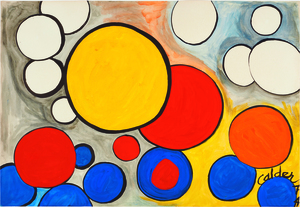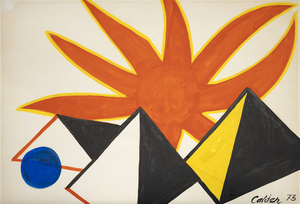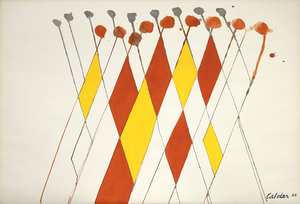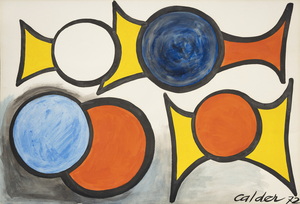ALEXANDER CALDER (1898-1976)










Provenance
Perls Gallery, New YorkPrivate Collection, acquired from the above
Exhibition
Crane Gallery, London, Calder: Oils, Gouaches, Mobiles and Tapestries, 5 March–1 May 1992History
Alexander Calder executed a surprising number of oil paintings during the second half of the 1940s and early 1950s. By this time, the shock of his 1930 visit to Mondrian’s studio, where he was impressed not by the paintings but by the environment, had developed into an artistic language of Calder’s own. So, as Calder was painting The Cross in 1948, he was already on the cusp of international recognition and on his way to winning the XX VI Venice Biennale’s grand prize for sculpture in 1952. Working on his paintings in concert with his sculptural practice, Calder approached both mediums with the same formal language and mastery of shape and color.
Calder was deeply intrigued by the unseen forces that keep objects in motion. Taking this interest from sculpture to canvas, we see that Calder built a sense of torque within The Cross by shifting its planes and balance. Using these elements, he created implied motion suggesting that the figure is pressing forward or even descending from the skies above. The Cross’s determined momentum is further amplified by details such as the subject’s emphatically outstretched arms, the fist-like curlicue vector on the left, and the silhouetted serpentine figure.
Calder also adopts a strong thread of poetic abandon throughout The Cross’s surface. It resonates with his good friend Miró’s hieratic and distinctly personal visual language, but it is all Calder in the effective animation of this painting’s various elements. No artist has earned more poetic license than Calder, and throughout his career, the artist remained convivially flexible in his understanding of form and composition. He even welcomed the myriad interpretations of others, writing in 1951, “That others grasp what I have in mind seems unessential, at least as long as they have something else in theirs.”
Either way, it is important to remember that The Cross was painted shortly after the upheaval of the Second World War and to some appears to be a sobering reflection of the time. Most of all, The Cross proves that Alexander Calder loaded his brush first to work out ideas about form, structure, relationships in space, and most importantly, movement.
MARKET INSIGHTS
- The graph by Art Market Research based in London shows that since January 1976, the value of artworks by Calder has increased by 3474.3%, with a compound annual growth rate of 7.6.
- While Calder was a prolific artist, oil on canvas paintings like The Cross are among the rarest examples of the artist’s work.
Comparable Paintings Sold at Auction

"Personnage" (1946) sold for $1,865,000 USD.
- Painted two years before The Cross
- Similar colors, but the abstraction in The Cross is more relatable
- Sold at auction in 2014, this painting would be worth well over $3m today

"Fond rouge" (1949) sold for $1,815,000 USD.
- Painted just one year after The Cross
- A nice abstraction, but not as exciting compositionally as The Cross
- The background here is only one color, while The Cross balances multiple hues in its background






















































